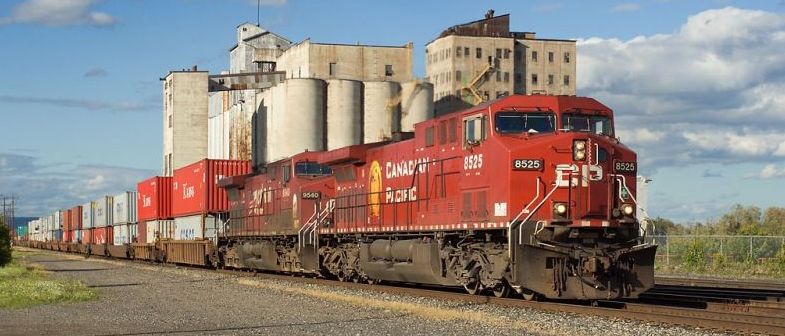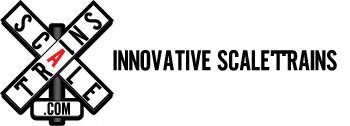Prototype History
Beginning in the 1950s, the Union Pacific Railroad sought higher and higher horsepower ratings from its locomotives to help move increasingly heavier and longer trains. Gas-Turbine Electric Locomotive (GTEL) technology promised much higher horsepower ratings over the diesel-electric locomotive designs of the time. General Electric (GE) and American Locomotive Co. (Alco) built the first GTEL design, a double-ended, 4,500 horsepower, B+B-B+B unit, delivered as UP #50 in 1949. This groundbreaking design would kick off the “Turbine Era” on the UP, which saw GE building successively larger and more powerful GTELs that would power UP’s hottest trains over the next two decades.
The basic principle of the GTEL saw a GE-designed and built gas turbine…essentially a type of jet engine…driving a generator that produced electricity, which was fed to traction motors on the locomotive’s axles. This design offered several advantages over more conventional diesel-electric locomotive designs of the era, particularly in horsepower. While competing cab and hood unit designs of the era boasted 1,500-1,750HP, the first GTELs boasted 4,500HP. Another advantage of the GTEL was it being designed to burn Bunker C heavy fuel oil, which, at the time, was much less expensive compared to conventional diesel fuel oil. GE would build successive batches of GTELs for UP, with each new design featuring improvements and design changes learned from experience from their predecessors.
All of those factors and lessons learned over the years would result in the ultimate GTEL design, the 8,500HP “Super Turbines” ordered in 1955. Indeed, design changes and technological improvements didn’t see the first of these units delivered until August 1958. These “C-C” (six-axle) units, numbered UP 1-15, with a second group, UP 16-30 also added to the order books, represented the pinnacle of the GTEL design from GE. Boasting 8,500HP, these units were built in a three-unit configuration, with an “A”, or Control Unit, which housed the operator’s cab, electrical control equipment, radiators, dynamic brakes, and a small 8-cylinder Bessemer-Cooper prime mover for hostling and auxiliaries. The semi-permanently coupled trailing “B”, or Turbine Unit, housed the heart of the machine: a GE 10-chamber centrifugal-flow gas turbine, coupled to a pair of 3,500HP electrical generators, which in turn powered all twelve powered axles under the pair of units.
While outwardly similar, there were a few external differences between the two groups; the first, UP 1-15, featured a “H-H” and “H-I” configuration on the dynamic brake housings of the A and B-units, so-called due to the appearance of the housing shape when viewed from above. The second group, UP 16-30, featured “H-I” and “I-I” dynamics as a spotting feature. However, this spotting feature would soon be rendered moot, due to several A and B-units between the two orders being swapped during maintenance.
Completing each set was a fuel tender trailing the B-unit, which held up to 24,000 gallons of Bunker C, which was heated by built-in electrical heater elements to keep the tar-like fuel in a viscous state. In an interesting melding of technology, the fuel tenders started out as steam locomotive tenders, salvaged and rebuilt from retired UP FEF-1 Northern and 4-6-6-4 Challenger steam locomotives. There were differences in how the tenders were (re)built; UP 1-20 were delivered with 24-C tenders, which featured insulation and a welded outer sheet metal jacket, giving them a smooth appearance. UP 21-30 were delivered with 23-C tenders, which had riveted construction and a body shorter in length in comparison to the 24-Cs. Eventually, tenders would be swapped between units as maintenance needs dictated, resulting in units originally equipped with 24-C tenders sporting 23-C tenders, and vice-versa.
The resulting 3-unit set (Control unit, Turbine unit, and tender) was massive, stretching almost 179 feet end-to-end, with the last unit, UP #30, delivered in June 1961. And their performance was impressive; put to work on UP’s Eastern District, they were commonly seen between Council Bluffs, IA, and Ogden, UT, hauling a variety of freight trains, frequently all by themselves. The deafening noise of their turbine engine and exhaust earned the Super Turbines the nickname “Big Blow”; so loud that UP reportedly restricted their operation in and around major cities due to noise complaints. Indeed, the City of Los Angeles was basically off-limits to the Big Blows and other GTELs after a few deafening visits in 1962. Nonetheless, the Big Blows made a name for themselves across the vast plains of Wyoming and Utah, often being heard from miles and miles out before they were even seen.
As with any other groundbreaking locomotive technology, in-service upgrades were implemented over their lifetimes to improve performance. In 1962, UP increased their rating to a whopping 10,000HP, which was subsequently dropped back down to their original 8,500 after a few years due to concerns of overloading their electrical systems. Many of the B-units were retrofitted with Farr-built “Dynavane” air intake systems for the turbine engine, resulting in a large, boxy structure jutting from the roof of the B-unit. Air requirements for the turbine were an issue early on, so much so that UP #30, the last unit built, came from GE with a one-of-a-kind intake system it would keep for its entire career. Horns on many were relocated from the operator’s cab roof (ironically due to crew noise complaints), to a location over the A-unit radiators, which also had the side benefit of keeping the horns from being fouled by snow and ice during winter.
Another visual change began appearing on many members of the fleet in 1962, which saw the original boxy diesel fuel tank under the A-unit replaced with a more angular high-capacity design, allowing for less-frequent trips to the fuel rack for the hostling engine. 1965 also saw the addition of Multiple-Unit, or MU equipment (additional pneumatic lines and electrical jumper connections), added to the rear of all but five of the B-units, allowing the Big Blows to operate in multiple with other locomotives.
Despite their outstanding performance, the Big Blows were to have relatively short careers. One of the contributing factors to this was rising fuel costs; the once-cheap Bunker C fuel oil the turbines were designed to burn, which refiners practically couldn’t give away early on, saw its price per gallon rise dramatically in the 1960s, eventually negating the fuel cost advantage the turbines enjoyed over their diesel-electric contemporaries. Rising maintenance costs compared to diesel-electrics also became an issue.
The turbine engines were complex pieces of machinery compared to a typical diesel prime mover, in particular the delicate turbine fan blades. These factors, along with advances in diesel-electric locomotive horsepower, and limitations on where the GTELs could operate, saw the first of the Big Blows, UP 1-4, retired in August 1968, after scarcely 10 years of service. Their numbers continued to dwindle over the last few years of the decade, with UP #7 holding the distinction of being the last Big Blow to operate, pulling its last train on December 26th, 1969. All were officially retired by February 1970, closing out the loud and exciting Turbine Era on the Union Pacific.
Road Number Specific ScaleTrains
- Era: Early 1960s to Present
- Displayed at the Illinois Railway Museum – Union, IL
- Series 16 to 30, built 8/60
- Road number 18
- 3-unit set: “A”, “B”, and Fuel Tender
- Premium leather-like presentation case with metal latches for safe storage
- Fully-assembled
- Multiple road numbers available
- Printing and lettering legible under magnification
- Operates on Code 70, 83, and 100 rail
- Minimum radius: 18” without water and electrical bus connections and tender truck safety chain detail attached
- Recommended radius: 22”
“A” Control Unit
- Operating LED-lit tricolor (red, green, and white) class lights**
- Operating LED-lit cab interior light
- Operating LED-lit control panel
- Operating LED-lit ground light on engineer’s side
- Operating LED-lit rear walkway light
- Printed and LED lighted number boards
- With nose side grab irons
- Opening cab doors with separate door handles
- Detailed cab interior with separate control stand, floor, rear wall with water cooler, and seats
- Radiator mounted lost wax brass Leslie S-5T-R air horn mounted on clearance bracket
- Cab roof heater box with grille on right side only
- Square base whip antenna
- Large see-through photo-etched metal side grilles
- H – I dynamic brake housing with etched-metal grilles
- With air intake scoops
- Modified radiator with all-weather shutter
- Underbody frame rail with traction motor cable detail
- As delivered 2,500 Gallon diesel fuel tank with extended retrofit
- Air tanks with separate plumbing
- Rubber Multiple Unit (MU) and electrical bus connections between the “A” and “B” units
- Rubber water hoses between the “A” and “B” unit
- Durable metal semi-scale Type E knuckle couplers
- Factory-applied ladders, wire grab irons, coupler cut levers, windshield wipers, mirrors, trainline hose, lifting lugs, exhaust stack, bell, and sanding lines
- Highly detailed trucks with separately applied brake cylinders, air pipes and lost wax brass wheel slip indicators on left side frames
- Mixed SKF and Timken bearings on right side truck frames
- Chicago Pneumatic speed recorder on second axle right side
- Motor with 5-pole skew wound armature
- Dual flywheels
- All-wheel drive
- All-wheel electrical pickup
- Directional LED headlight
- DCC & sound equipped locomotives feature:
- Operates on both DC and DCC layouts
- ESU LokSound 5 DCC & Sound decoder with “Full Throttle” feature
- Prime mover sound
- Curve squeal sound
- Frog clank sound
- Large oval speaker
- ESU designed “PowerPack” with two super capacitors***
- DC/DCC & sound ready locomotives feature:
- Operable using a DC power pack
- DCC-ready with 21-pin connector
“B” Turbine Unit
- Operating LED-lit back-up light
- Sliding engine compartment side doors
- Detailed interior with turbine visible inside
- Spinning turbine fan blade visible inside exhaust
- Farr Dynavane inertial type air intake housing
- I – I dynamic brake housing with etched-metal grilles
- Offset air intake scoops
- Blanked door panels
- With rear MU connections
- Factory-applied ladders, wire grab irons, coupler cut levers, trainline hose, lifting lugs, and sanding lines
- Underbody frame rail
- Highly detailed trucks with separately applied brake cylinders, air pipes and lost wax brass wheel slip indicators on left side frames
- Timken bearings on right side truck frames
- Motor with 5-pole skew wound armature
- Dual flywheels
- All-wheel drive
- All-wheel electrical pickup
- DCC & sound equipped locomotives feature:
- Operates on both DC and DCC layouts
- ESU LokSound 5 DCC & Sound decoder with “Full Throttle” feature
- Turbine sound
- Curve squeal sound
- Frog clank sound
- Large oval speaker
- ESU designed “PowerPack” with two super capacitors***
- DC/DCC & sound ready locomotives feature:
- Operable using a DC power pack
- DCC-ready with 21-pin connector
24C Fuel Tender
- 24,000-gallon capacity
- Welded seams
- Insulated
- Commonwealth 6-axle trucks
- Truck chains
- Factory-applied air tank, brake cylinder, and control valve
- Factory-applied multiple unit (MU) hoses
- Photo-etched metal tender deck walkway
- Operating LED-lit rear tender light
* Lighting features operate when using an ESU decoder with appropriate programming while operating using DCC
** During DC operation, class lights illuminate in white. Access to other colors and the ability to change colors requires an ESU DCC decoder while operating in DCC
*** Compatible with appropriately programmed ESU decoders while operating using DCC














